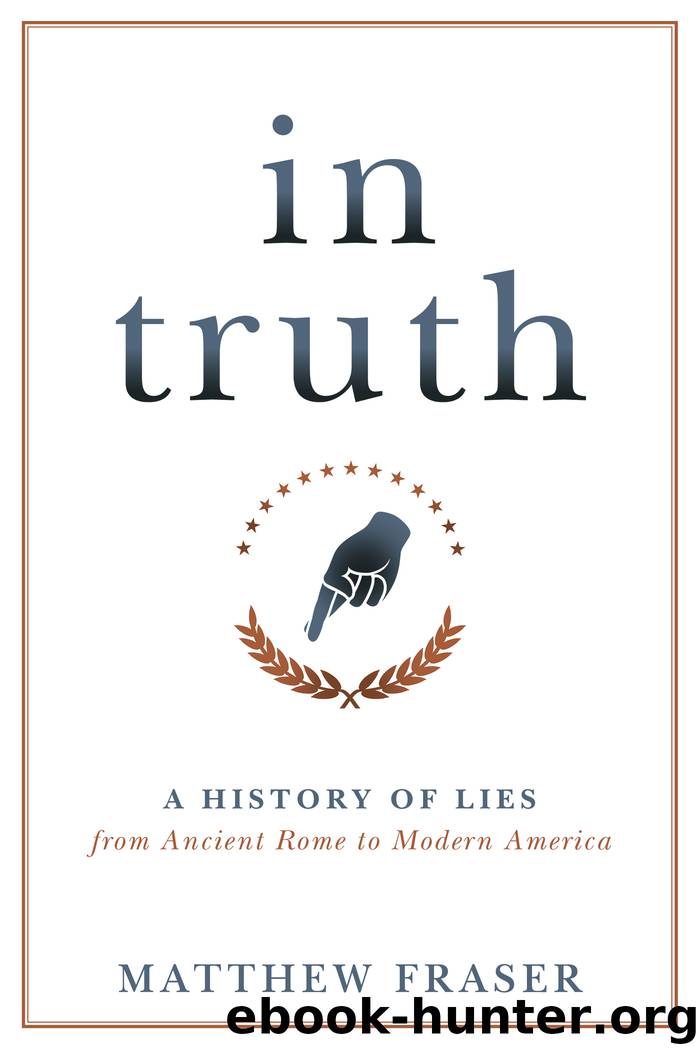In Truth by Matthew Fraser

Author:Matthew Fraser
Language: eng
Format: epub
Tags: undefined
Publisher: Prometheus
Published: 2012-04-15T00:00:00+00:00
The last sentence revealed that Locke was still spinning his exaggerated boast about being a direct descendant of philosopher John Locke.
Not all fake news stories of the era aspired to satire. Some were intended to terrify. In November 1874, the New York Herald published a ten-thousand-word story headlined “A Shocking Sabbath Carnival of Death,” about wild animals escaping the Central Park Zoo. The story’s subheading warned “Savage Brutes at Large” and “Awful Combats between Beasts and Citizens.” The beasts—Numidian lions, panthers, Bengal tigers, polar bears, hyenas—had broken free after a rhinoceros trampled and killed a zookeeper by plunging its horn into his head. The Herald story, written by Irish American journalist Joseph Clarke, reported that wild animals rampaging through the streets of Manhattan had killed two hundred people. “Men and women rushed in all directions away from the beast, who sprang upon the shoulders of an aged lady, burying his fangs in her neck and carrying her to the ground.” A panther was spotted gnawing on its victim; another had attacked worshippers in a church on West 53rd Street.
The Herald’s reports of “terrible scenes of mutilation” provoked widespread panic. Men were seen racing around the streets of Manhattan carrying rifles. Parents rushed to retrieve their children from school. To reassure readers, the Herald announced that the National Guard had converged on the city to confront the uncaged beasts.[32]
Why did people believe it? One reason was ignorance about zoos and wild animals. Zoos were a relatively new phenomenon in the 1870s. The Central Park Zoo had opened as a menagerie only a decade earlier in 1864. Most people in cities like New York were unfamiliar with exotic beasts and knew nothing of their behavior. It was entirely plausible that lions and tigers could escape and attack humans. Most readers—including editors at rival papers—failed to spot the newspaper’s disclaimer, tucked away at the bottom of the story: “The entire story given above is a pure fabrication. Not one word of it is true.” The Herald’s competitors were quick to denounce the story, though their moral outrage concealed competitive jealousy. Fake news sold papers.
It’s easy to disparage penny papers like the Sun and the Herald for pandering to the bottom of the market with outlandish fake news stories. It must be remembered, however, that these papers invented modern journalism. True, they were the precursors of modern tabloids that continued the tradition of scandal-mongering and fake news. But they were also the first papers to hire reporters to find stories and cover the news. As astonishing as it may seem, early newspapers didn’t have their own reporters. New York papers covered Washington, DC, by reprinting official documents and publishing reports written up by members of Congress—in effect, free political publicity. This was much like the European tradition, where editors like Theodor Fontane in Germany pinched stories from other papers and invented details to create the impression that they were real foreign correspondents. It was the penny press, not the broadsheets, that invested in newsgathering and hired reporters to dig for news.
Download
This site does not store any files on its server. We only index and link to content provided by other sites. Please contact the content providers to delete copyright contents if any and email us, we'll remove relevant links or contents immediately.
Cecilia; Or, Memoirs of an Heiress — Volume 1 by Fanny Burney(32489)
Cecilia; Or, Memoirs of an Heiress — Volume 2 by Fanny Burney(31908)
Cecilia; Or, Memoirs of an Heiress — Volume 3 by Fanny Burney(31884)
The Great Music City by Andrea Baker(31750)
We're Going to Need More Wine by Gabrielle Union(18997)
All the Missing Girls by Megan Miranda(15751)
Pimp by Iceberg Slim(14431)
Bombshells: Glamour Girls of a Lifetime by Sullivan Steve(14019)
For the Love of Europe by Rick Steves(13469)
Talking to Strangers by Malcolm Gladwell(13281)
Norse Mythology by Gaiman Neil(13264)
Fifty Shades Freed by E L James(13184)
Mindhunter: Inside the FBI's Elite Serial Crime Unit by John E. Douglas & Mark Olshaker(9257)
Crazy Rich Asians by Kevin Kwan(9214)
The Lost Art of Listening by Michael P. Nichols(7449)
Enlightenment Now: The Case for Reason, Science, Humanism, and Progress by Steven Pinker(7270)
The Four Agreements by Don Miguel Ruiz(6691)
Bad Blood by John Carreyrou(6579)
Weapons of Math Destruction by Cathy O'Neil(6204)
